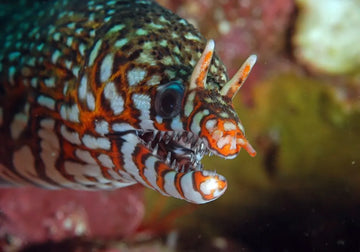Our seas and oceans are home to over 200 different species of moray eels, varying in size and color depending on location and species. Despite having a body similar to that of snakes, they are anguilliform fish, characterized by a long body, which can reach up to 13 meters in length, and a prolonged snout. These fish inhabit tropical and subtropical waters worldwide, both in coral reefs and in rocky areas with cracks and caves.
By the way, for marine life enthusiasts like you, we've created this collection of t-shirts for ocean lovers. With free shipping on orders over €65 worldwide. Place your order now!

Moray eels have in their formidable mouth two sets of jaws and teeth: the visible one they use to capture their prey, and the inner one, called the pharyngeal jaw, located in their throat. With these supplementary jaws, they catch the prey and transport it to the throat to crush and digest it. This is the only known animal with this curious design. Another difference between moray eels and other fish is that they lack scales, and their body is covered with a toxic mucus.
Most moray eel specimens have dark colors to go unnoticed among rocks and in murky waters where they live, ranging from black to brown, gray, or olive green. But there are also others with bright orange, red, and yellow colors.
Moray eels are fast swimmers that use very little energy to move, snaking, as they lack pectoral and pelvic fins but have a dorsal fin that covers their entire body.
Moray eels have very poor eyesight but an excellent sense of smell, which they use to capture prey during the night. These voracious fish feed on a variety of fish, cephalopods, and crustaceans.
 Moray eel guarding its cave. Source
Moray eel guarding its cave. Source
Although they are aggressive animals, they usually avoid contact with divers and are quite shy, hiding in cracks and crevices when they feel threatened.





















